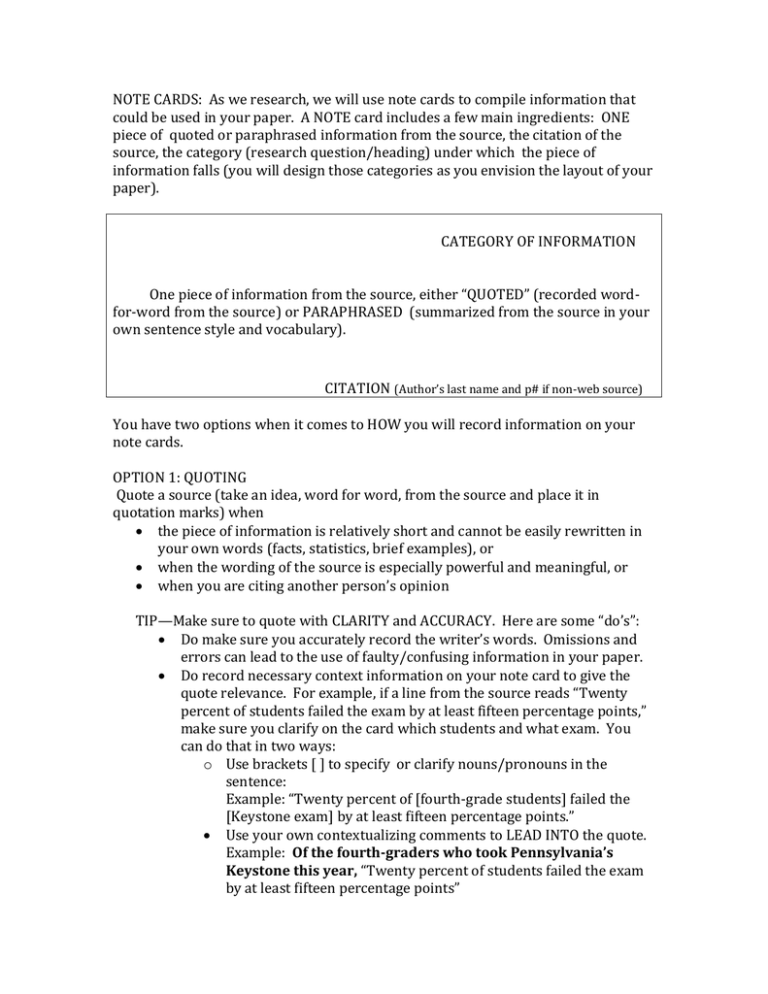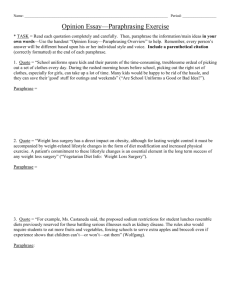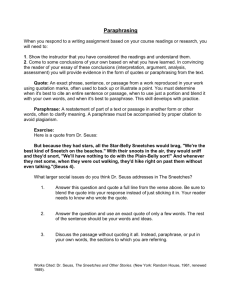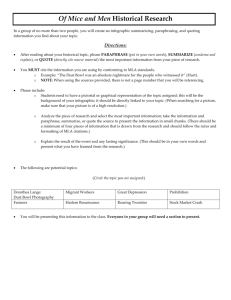NOTE CARDS: As we research, we will use note... could be used in your paper. A NOTE card...
advertisement

NOTE CARDS: As we research, we will use note cards to compile information that could be used in your paper. A NOTE card includes a few main ingredients: ONE piece of quoted or paraphrased information from the source, the citation of the source, the category (research question/heading) under which the piece of information falls (you will design those categories as you envision the layout of your paper). CATEGORY OF INFORMATION One piece of information from the source, either “QUOTED” (recorded wordfor-word from the source) or PARAPHRASED (summarized from the source in your own sentence style and vocabulary). CITATION (Author’s last name and p# if non-web source) You have two options when it comes to HOW you will record information on your note cards. OPTION 1: QUOTING Quote a source (take an idea, word for word, from the source and place it in quotation marks) when the piece of information is relatively short and cannot be easily rewritten in your own words (facts, statistics, brief examples), or when the wording of the source is especially powerful and meaningful, or when you are citing another person’s opinion TIP—Make sure to quote with CLARITY and ACCURACY. Here are some “do’s”: Do make sure you accurately record the writer’s words. Omissions and errors can lead to the use of faulty/confusing information in your paper. Do record necessary context information on your note card to give the quote relevance. For example, if a line from the source reads “Twenty percent of students failed the exam by at least fifteen percentage points,” make sure you clarify on the card which students and what exam. You can do that in two ways: o Use brackets [ ] to specify or clarify nouns/pronouns in the sentence: Example: “Twenty percent of [fourth-grade students] failed the [Keystone exam] by at least fifteen percentage points.” Use your own contextualizing comments to LEAD INTO the quote. Example: Of the fourth-graders who took Pennsylvania’s Keystone this year, “Twenty percent of students failed the exam by at least fifteen percentage points” OPTION 2: PARAPHRASING To paraphrase means to put another’s idea into your own sentence style and vocabulary. Paraphrase when you want to summarize a page or a paragraph describing one idea into a few sentences (anecdotes, long examples, extensive studies) the original idea is written in a complicated way and it needs to be simplified for the reader of your paper Students can accidently plagiarize when they do not paraphrase carefully. Some tips to avoid that situation: Make sure you change BOTH the VOCABULARY AND sentence STRUCTURE/STYLE of the original source’s writing. Only doing one is insufficient. Do not look at the source while paraphrasing. Read it. Put it down. Write a summary. Re-read source to make sure you’ve got the facts straight. It’s difficult to paraphrase ONE simple sentence. For example, if the source reads “Two dozen officers were killed last year,” it would be tough to paraphrase without using what’s already there. It’s better to simply quote the source in such situations. _______________________________________________________________________________________________ NO (SAT is inaccurate predictor) “De Pauw University… asked its institutional research department to do a study on past students to see which factors correlated with academic success, ‘The one thing that made no difference whatsoever was standardized test scores,’ said Cindy Babington, vice president for student services.” (Rosenberg) NO (SAT is inaccurate predictor) Sheyenne Brown, a disadvantaged student from the Bronx who scored below Middlebury’s average SAT score but was admitted to the school through the Posse program, ended up graduating from the school cum laude. Her example proves that low SAT scores do not necessarily indicate that a student will not do well in college. (Rosenberg)



